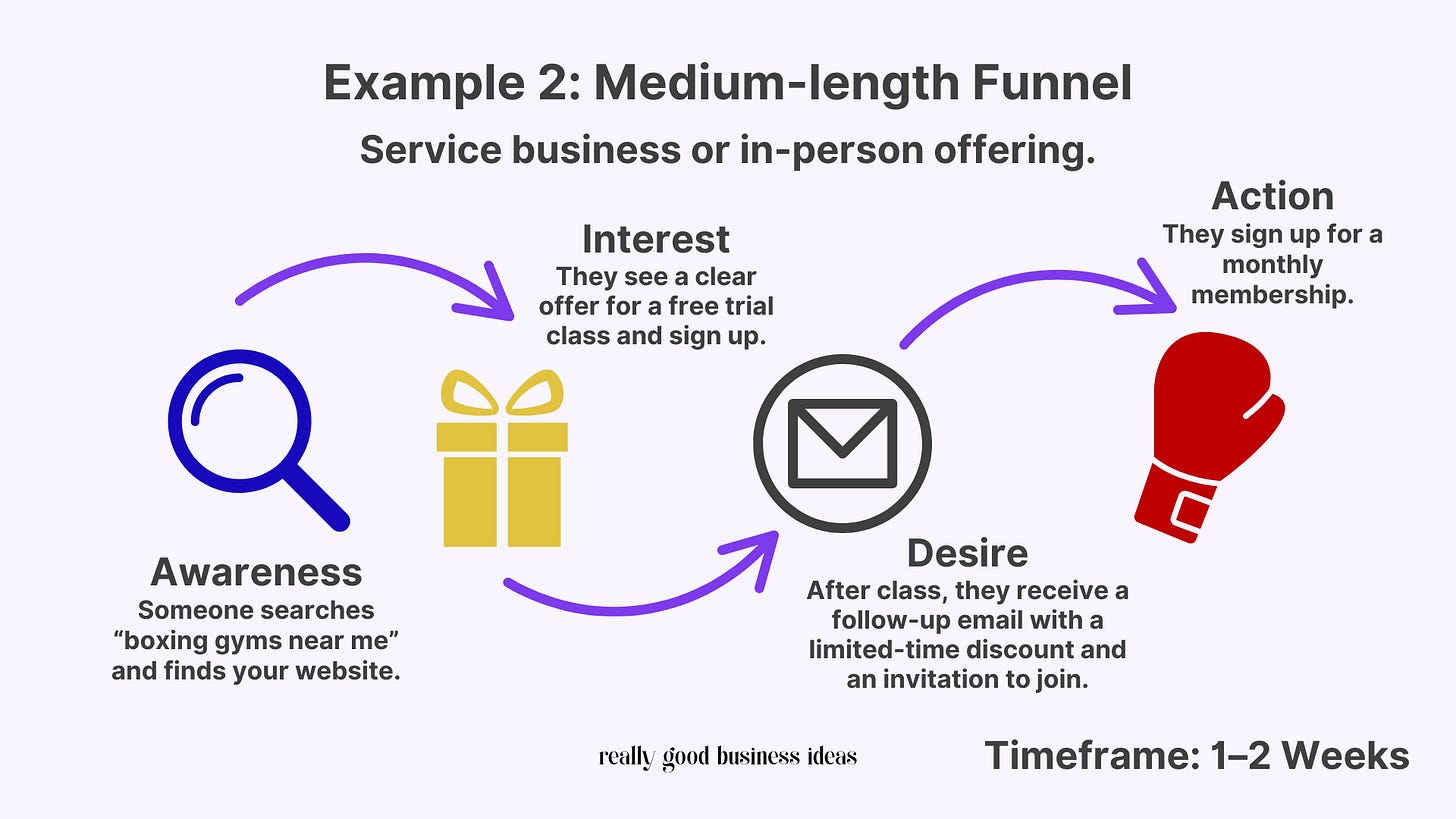Unlock Steady Growth With One Simple Tool: A Funnel
If growth feels confusing, this is the missing link that makes everything click.
You’re doing the work. You’re showing up. You’ve got the product, the offer, the drive.
But the growth? It’s…not happening. Or, at least, not fast enough.
If you’ve ever felt like your business should be growing but you can’t figure out what’s missing, you’re not alone. Most businesses don’t fail because the idea isn’t good—they fail because they don’t have a system that turns interest into action.
That system is called a funnel. And once you understand how it works, everything falls into place.
What Is a Funnel (And Why Does It Matter)?
A funnel is the step-by-step journey someone takes from discovering your business to deciding to buy.
It’s how you turn distribution into revenue, guiding people from “just found you” to “just bought from you.” And if you don’t understand how that journey works, it’s no wonder growth feels unpredictable.
Most entrepreneurs and creators focus on the visible parts of their business: making great products, posting consistently, and refining their pitch. But if people aren’t moving toward a purchase—or they’re dropping off halfway—it’s often the path to the product that’s missing or unclear.
Think of it like this: imagine walking into a store where no one greets you, the layout is confusing, and there’s no checkout in sight. That’s what your online presence feels like without a funnel. A good funnel acts like a helpful guide by welcoming people in, showing them around, answering their questions, and making it easy for them to buy.
Without a funnel, people get lost. With one, people convert.
The Key Stages of a Funnel (And Why It’s Not Always Linear or Fast)
Most funnels follow a few key stages. You might’ve heard of AIDA—Awareness, Interest, Desire, Action—but you don’t need to memorize acronyms. The idea is simple: help people move from discovering you to choosing you.
Here’s how that typically plays out:
Awareness: They discover you for the first time.
Interest: They learn what you do and why it matters.
Desire: They start to want what you’re offering.
Action: They take the leap and buy, book, or sign up.
Sounds clean and tidy, right? But in real life, it’s messier.
People don’t always move in order. Some skip straight to the sale because a friend referred them. Others sit in the “interest” phase for weeks, quietly lurking on your posts. Some need to loop back to “awareness” after losing track of you.
Why Your Funnel Needs Throughput
Funnels aren’t magic; they’re multipliers. But even the best-designed funnel can’t multiply zero.
That means you need to fill your funnel.
No traffic? No conversions.
No visibility? No sales.
No discovery? No one even gets the chance to want what you offer.
Funnels only work when something flows through them. That means you don’t just need a funnel—you need throughput.
Top-of-funnel activities, like social media, search engine optimization, paid ads, and partnerships, bring people into your world. Without them, your funnel’s just a well-organized ghost town.
Not everyone converts. That’s normal.
It’s called a funnel because that’s how your audience behaves: wide at the top, with lots of people becoming aware of you, but fewer and fewer sticking around as they move toward taking action.
Let’s say:
1,000 people see your content.
200 visit your site.
40 sign up for a lead magnet.
10 end up buying.
That’s a 1% conversion from awareness to action—totally typical. If you want more buyers, you can do one of two things:
Improve your conversion rate.
Increase your traffic.
If you already have serious volume, improving conversion might move the needle more.
But for most small businesses and early-stage creators? It’s usually easier to double your traffic than to double your conversion rate.
That’s why structure and distribution go hand in hand. A great funnel with no traffic won’t grow your business. And all the traffic in the world won’t help if there’s nowhere for it to go.
What a Funnel Looks Like in Real Life
Let’s bring this to life with some real-world examples. Funnels don’t always behave like perfect diagrams. Sometimes, they’re as simple as a few smart steps that guide someone from curious to committed; other times, they're a months-long process involving many different touchpoints.
But whether you’re selling products, services, or content, the overall structure stays the same.
Example 1: Simple, Fast Funnel
Low-friction product or impulse buy.
Awareness: Someone sees your Instagram reel about a new enamel mug.
Interest: They tap through to your product page.
Desire: They skim the reviews, see a limited-time discount, and think, “This is cute and cheap.”
Action: They buy it on the spot.
Timeframe: 5 minutes.
Example 2: Medium-length Funnel
Service business or in-person offering.
Awareness: Someone searches “boxing gyms near me” and finds your website.
Interest: They see a clear offer for a free trial class and sign up.
Desire: After the class, they receive a follow-up email with a limited-time discount, member testimonials, and an invitation to join.
Action: They sign up for a monthly membership.
Timeframe: 1–2 weeks.
Example 3: Long-form Funnel
Course, coaching, or B2B.
Awareness: Someone hears you as a guest on a podcast.
Interest: They check out your site and join your newsletter for a free mini-training.
Desire: They engage with 2–3 months of emails, read your testimonials, and attend a live webinar.
Action: They sign up for your course or apply to work with you 1:1.
Timeframe: 1–3+ months.
Each funnel fits the offer. What matters isn’t the length or the format—it’s that you’re meeting people where they are and guiding them through.
Every business has a funnel, whether you’ve intentionally built it or not. But once you map it, you can improve it. And when you improve it, you grow.
🚨 Remember: These are just examples. Real-life funnels are rarely this tidy.
Some people buy instantly. Others circle for weeks.
Some skip steps. Others need every touchpoint.
That’s normal.
The goal isn’t to force everyone into the same path—it’s to create a clear path for the right people to follow.
Common Funnel Mistakes (and How to Avoid Them)
Funnels don’t have to be perfect, but they do need to be intentional. These are the most common mistakes that hold people back from getting the results they want:
Mistake 1: Skipping Steps
Trying to sell before building trust is like proposing on the first date. If someone doesn’t understand what you do—or why they should care—they’re not going to convert.
The Fix: Make sure your funnel has touchpoints that educate and build trust before the ask.
Mistake 2: Doing Too Much at Once
If your page presents multiple offers, too many calls to action, and a cluttered layout, it creates confusion. And confused visitors don’t stick around—they leave and may never return.
The Fix: Keep your funnel focused. One offer, one clear action per stage. Make it obvious what you want customers to do next.
Mistake 3: No Call to Action
People might genuinely enjoy your content, but without a clear next step, they won’t know how to go deeper, stay connected, or take action.
The Fix: Every stage in the funnel should include a clear, obvious next step. Don’t make people guess.
Mistake 4: Not Tracking Anything
People might love what you’re putting out, but if you’re not tracking their behavior, you’ll never know where in the funnel they’re getting stuck or dropping off..
The Fix: Utilize simple analytics tools, such as Google Analytics, Substack stats, or email platforms, to track key metrics like link clicks, open rates, and page views. Even basic data can show you what’s working and where people lose interest.
Mistake 5: Not Filling the Funnel
Even the best-designed funnel won’t work if no one’s moving through it. Without traffic at the top, there’s nothing to convert at the bottom.
The Fix: Pair your funnel with consistent top-of-funnel activity—whether that’s social posts, SEO content, collaborations, or paid ads. Funnels don’t work in isolation; they need throughput to function.
How to Start Building Your Funnel Today
Don’t overthink it. You don’t need a 10-step automation or a fancy tech stack. Start with one offer and one clear path—then make sure people are actually flowing through it.
Here’s how:
1. Pick One Offer
This could be a product, service, newsletter, or lead magnet. Focus matters. If your funnel has too many destinations, no one knows where to go.
2. Map the Path
Ask yourself:
How do people find it?
What do they learn next?
What builds trust?
What makes them say yes?
3. Sketch It Out
Use paper, a Google Doc, Notion, or even a napkin. The format doesn’t matter, seeing it laid out does.
4. Improve the Weakest Link
Pick the stage that needs the most love: your call to action, your follow-up email, your landing page, etc. Small tweaks can have a big impact.
5. Drive Throughput.
Once the structure is there, feed it traffic. Post. Partner. Promote. Funnels only work when people are flowing through them.
🚨 Remember: You can’t optimize a funnel no one’s using.
You need volume to see where people drop off, what resonates, and what needs work. The data comes after the traffic.
Start small, stay focused, and build from there. The magic is in the momentum.
Funnels Are the System Behind Sustainable Growth
Funnels aren’t just for tech bros or big marketing teams. They’re for anyone who wants to grow—creators, consultants, indie businesses, and side hustlers alike.
Because growth isn’t just about working harder, it’s about removing friction, creating clarity, and guiding people from “just found you” to “just bought.”
Remember:
Funnels don’t need to be complicated.
They don’t need to be perfect.
They just need to be intentional.
Start simple. Map one clear path. Test it. Tweak it. Let it evolve.
Stuck in a Growth Plateau? It’s Time for a Reset.
Growth Reset is a 3 month program to help you diagnose what’s actually holding your business back—and fix it. Whether your traffic dried up, your funnel’s leaking, or your offer’s no longer landing, this isn’t about hustle. It’s about clarity.
You’ll get:
A step-by-step framework to investigate your slowdown.
Tactical experiments to reboot traction.
Feedback, support, and accountability along the way.
Stop guessing. Start growing.
Join the waitlist for Growth Reset → growthreset.co
To endless possibilities,
Casandra









One confusing piece for me has been figuring out which content is TOFU and which can be for more 'educated readers' - probably content that everyone can understand should be via linkedin while the deeper and conversion friendly content goes into long-form and email courses/free courses to build trust
Super helpful for a new Substacker like me. I find myself overwhelmed, probably like many others, navigating this funnel. It is about removing friction and this is now my template to follow. Thanks Casandra!